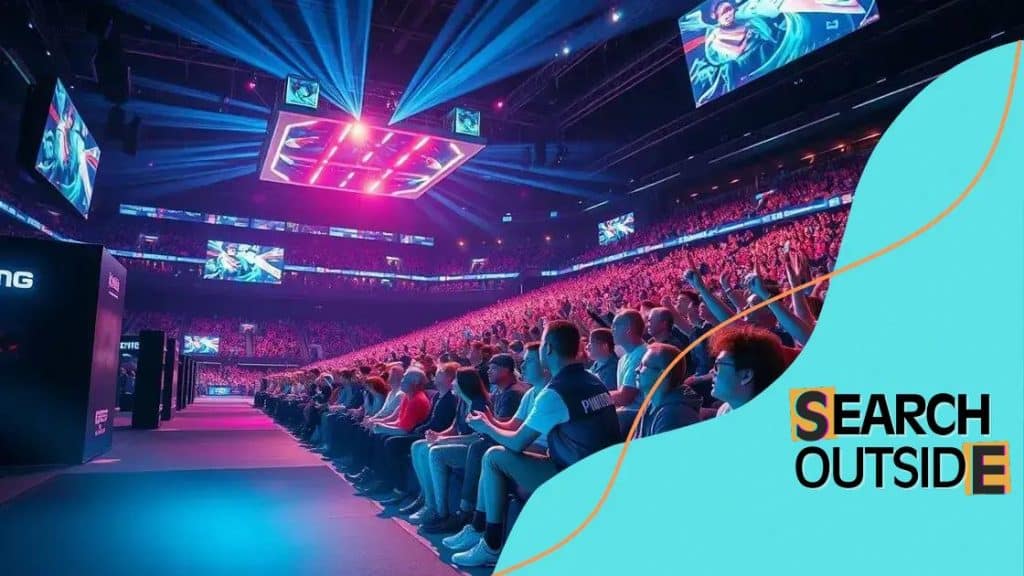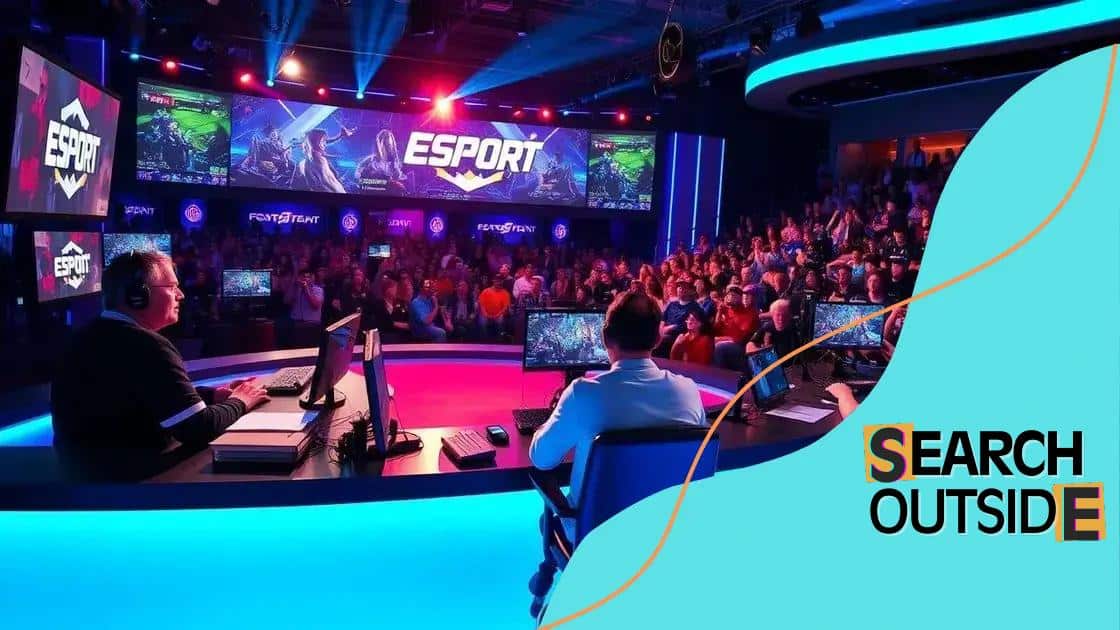How e-sports are influencing mainstream media content

How e-sports are influencing mainstream media content is evident through new broadcasting methods, audience engagement strategies, and collaborations that integrate advanced technologies like VR and AR, reshaping viewer experiences and expanding the industry’s reach.
How e-sports are influencing mainstream media content is a question many are asking as these competitive games gain traction. From viewership to collaborations, the effects on traditional media are profound. Let’s dive into this growing phenomenon.
The rise of e-sports in popular culture
The rise of e-sports has transformed popular culture in remarkable ways. Once considered a niche hobby, competitive gaming has become a global phenomenon, attracting fans from diverse backgrounds. E-sports events are now filling arenas, indicating a shift in how audiences perceive gaming as a mainstream form of entertainment.
Changing Perceptions
As e-sports gains popularity, the stigma attached to gaming is diminishing. More people are acknowledging e-sports as a legitimate form of competition, similar to traditional sports. This change is evident in how e-sports is covered in media, with major news outlets dedicating time to report on tournaments and player achievements.
Famous E-sports Tournaments
Some of the most prestigious events in e-sports draw thousands of live attendees and millions of online viewers. These tournaments have showcased exceptional talent and created superstars.
- World Championship Series (WCS)
- The International (Dota 2)
- League of Legends World Championship
These events also bring significant attention from sponsors and advertisers, demonstrating the commercialization of e-sports. Advertisements and branded content permeate through live broadcasts and online streams, contributing to a multi-billion-dollar industry.
Influence on Mainstream Media
The influence of e-sports extends into mainstream media, as television networks and streaming platforms vie to capture e-sports content. Partnerships with established traditional sports leagues have emerged, creating cross-promotional opportunities. This collaboration not only legitimizes e-sports but also invites a broader audience, paving the way for future growth.
Overall, the e-sports landscape is an exciting intersection of technology, culture, and entertainment. As it continues to rise, it redefines expectations and breaks down barriers between gaming and traditional media, influencing everything from advertising to viewer engagement.
E-sports viewership and its demographics
E-sports viewership is expanding rapidly, creating a vibrant and diverse audience. Unlike traditional sports, the demographics of e-sports fans are unique and multifaceted, attracting viewers of various ages, genders, and backgrounds. This blend of demographics makes the e-sports community particularly engaging.
Who are the Viewers?
The majority of e-sports fans are young, with a significant portion under 35 years old. However, older fans are increasingly tuning in, creating a wider spectrum of viewership. This range indicates a shift in cultural acceptance of gaming as a mainstream form of entertainment.
- Age Distribution: Over 70% of viewers are aged 18-34.
- Gender Demographics: Approximately 40% of e-sports fans are female.
- Global Reach: E-sports attracts viewers from all around the world, with major audiences in North America, Europe, and Asia.
Understanding these demographics is crucial for brands and advertisers looking to tap into this growing market. Many companies recognize the potential of engaging with this audience through targeted marketing campaigns. They utilize e-sports sponsorships and advertisements to reach young consumers.
Viewing Habits
E-sports viewership also differs from traditional sports in terms of platforms. Most fans watch matches online via streaming services like Twitch and YouTube. This shift has influenced how e-sports tournaments are produced and presented, as viewers prefer interactive experiences and engaging content. Social media plays a vital role in fostering community and engagement, as fans discuss games and players on various platforms.
Overall, the dynamics of e-sports viewership highlight the significance of understanding audience preferences. As this sector continues to grow, it presents new opportunities for content creators and marketers alike.
Mainstream media collaborations with e-sports

Mainstream media collaborations with e-sports are becoming increasingly common. Television networks, streaming platforms, and sports organizations recognize the excitement and potential of e-sports. This recognition has led to innovative partnerships that bring competitive gaming into the spotlight.
Television Networks Embrace E-sports
Many television networks now broadcast e-sports tournaments, showcasing matches to millions of viewers. These broadcasts often include expert commentary and highlight reels, similar to traditional sports coverage. Such exposure helps to legitimize e-sports in the eyes of a broader audience. Networks like ESPN and Turner Sports have created dedicated segments for e-sports, allowing fans to follow their favorite games and players.
Streaming Platforms & E-sports
Streaming platforms such as Twitch and YouTube have revolutionized how e-sports content is consumed. These platforms provide fans with access to live tournaments and exclusive content. In collaboration with game developers and tournament organizers, these platforms offer an interactive viewing experience. Fans can engage with each other and the streamers, creating a sense of community around their favorite games.
- Live Streaming: Fans can watch tournaments as they happen.
- Exclusive Content: Behind-the-scenes footage and player interviews.
- Community Engagement: Viewers can chat during streams, sharing their thoughts in real time.
Additionally, many companies are creating original content around e-sports. Documentaries and reality shows highlight the lives of professional gamers, providing fans with a glimpse into their favorite competitors’ routines and training sessions. These shows attract not only hardcore gamers but also those who may be unfamiliar with e-sports.
Collaborations between traditional sports franchises and e-sports organizations are also on the rise. This trend brings a unique synergy, as established sports teams create e-sports divisions, recruiting top players and participating in competitive gaming leagues. This cross-pollination helps to grow the audience for both sectors, blending the excitement of physical sports with the digital arena.
Impact of e-sports on traditional broadcasting
The impact of e-sports on traditional broadcasting is significant and transformative. As e-sports continues to rise in popularity, this competitive gaming format is reshaping how audiences consume media. Traditional broadcasters are adapting to this new landscape by incorporating e-sports into their programming.
Changing Broadcasting Strategies
Television networks are exploring new ways to engage viewers through e-sports content. By airing live tournaments and gaming competitions, they attract a younger audience that often prefers streaming platforms. This shift forces traditional media to innovate, leading to enhanced programming that includes interactive elements and real-time statistics.
Sponsored Content and Partnerships
Many broadcasters are forming partnerships with e-sports organizations. This collaboration allows them to create sponsored content that resonates with fans. These partnerships often result in unique formats, such as behind-the-scenes documentaries, which provide insight into the competitive gaming world.
- Formats Offered: Live tournaments, reality shows, and player interviews.
- Audience Engagement: Interactive polls and social media integration.
- Revenue Opportunities: Increased sponsorship deals and advertising revenue.
This blending of e-sports with traditional broadcasting enhances viewer experience. Audiences enjoy insights into strategies and gameplay, making the viewing process more engaging than conventional sports coverage. Broadcasters now use advanced graphics and commentary that mirror the excitement of watching a sports game.
Furthermore, as e-sports gains traction, some traditional sports leagues are looking to e-sports to attract a tech-savvy audience. This trend results in innovative formats where fans can enjoy both traditional sports and e-sports in one event, enhancing overall fan engagement.
Future trends: e-sports and media innovation
Future trends in e-sports are set to drive media innovation in exciting ways. As technology advances, the integration of new platforms and interactive content will redefine how fans engage with e-sports. This evolution will create immersive experiences and expand the audience base significantly.
Advanced Viewing Experiences
The use of virtual reality (VR) and augmented reality (AR) is likely to transform e-sports broadcasting. Fans will soon be able to experience games from a first-person perspective, making them feel as if they are part of the action. This technology allows viewers to interact with the game in ways never before possible.
Interactive Content
Interactivity will play a major role in the future of e-sports. Live streaming platforms may introduce features that allow viewers to influence game outcomes through voting or choices. This engagement will not only enhance the viewing experience but also foster a sense of community among fans.
- Fan Engagement: Opportunities for real-time audience participation.
- Gamification: Incorporating game-like elements into the viewing experience.
- Social Integration: Opportunities for viewers to connect and share experiences on social platforms.
Furthermore, the rise of blockchain technology is poised to create new avenues for ownership and revenue. By using cryptocurrencies and decentralized platforms, fans could buy in-game assets and have a stake in the e-sports ecosystem.
The relationship between brands and e-sports is also evolving. Companies are increasingly looking for unique ways to connect with players and fans through personalized marketing and branded content. As e-sports continues to grow, brands will evolve their strategies to reach this dynamic audience.
Overall, the future of e-sports will significantly influence media innovation, leading to new experiences that are more engaging and interactive. The blend of technology and creativity will continue to reshape the landscape, offering fans new ways to enjoy and connect with their favorite games.
FAQ – Frequently Asked Questions about E-sports Influence on Media
How is e-sports changing traditional media?
E-sports is reshaping traditional media by integrating new broadcasting methods and creating opportunities for interactive viewer engagement.
What technologies are influencing the future of e-sports?
Technologies like virtual reality (VR) and augmented reality (AR) are set to enhance the viewing experience for e-sports fans.
How do brands partner with e-sports organizations?
Brands collaborate with e-sports organizations through sponsorships and creating engaging content to reach a wider audience.
Why is audience engagement important in e-sports?
Audience engagement enriches the viewing experience, fosters community interaction, and drives viewer loyalty, which is vital for the growth of e-sports.





